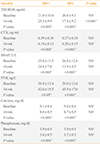Abstract
Background
Methods
Results
Conclusion
Figures and Tables
Fig. 1
Randomization scheme and patient disposition. IBN+, the group which received a once-monthly pill containing 150 mg ibandronate and 24,000 IU cholecalciferol; IBN, the group which received a once-monthly pill containing 150 mg ibandronate.

Fig. 2
Changes in mean serum 25(OH)D levels over the 16-week treatment period. IBN+, the group which received a once-monthly pill containing 150 mg ibandronate and 24,000 IU cholecalciferol; IBN, the group which received a once-monthly pill containing 150 mg ibandronate; 25(OH)D, 25-hydroxyvitamin D. aP<0.001.

Fig. 3
Changes in the distribution of patients according to 25-hydroxyvitamin D (25[OH]D) levels after the 16-week treatment period. IBN+, the group which received a once-monthly pill containing 150 mg ibandronate and 24,000 IU cholecalciferol; IBN, the group which received a once-monthly pill containing 150 mg ibandronate treatment period, grouped by baseline 25(OH)D levels.

Table 1
Baseline Characteristics of the Participants

Values are expressed as mean±SD or number (%).
IBN+, the group which received a once-monthly pill containing 150 mg ibandronate and 24,000 IU cholecalciferol; IBN, the group which received a once-monthly pill containing 150 mg ibandronate; NS, not significant; BMD, bone mineral density; 25(OH)D, 25-hydroxyvitamin D; PTH, parathyroid hormone; BSAP, bone-specific alkaline phosphatase; CTX, C-telopeptide of type 1 collagen.
Table 2
Changes in the Serum Levels of 25(OH)D, Bone Turnover Markers, Parathyroid Hormone, Calcium, and Phosphorus after the 16-Week Treatment Course

Values are expressed as mean±SD.
25(OH)D, 25-hydroxyvitamin D; IBN+, the group which received a once-monthly pill containing 150 mg ibandronate and 24,000 IU cholecalciferol; IBN, the group which received a once-monthly pill containing 150 mg ibandronate; NS, not significant; CTX, C-telopeptide of type 1 collagen; BSAP, bone-specific alkaline phosphatase; PTH, parathyroid hormone.
aWilcoxon's rank sum test; bWilcoxon's signed rank test; ct test; dPaired t test.
Table 3
Changes in the Mean Serum Levels of 25(OH)D and CTX after the 16-Week Treatment Course, Grouped by Baseline 25(OH)D Levels

Values are expressed as mean±SD.
25(OH)D, 25-hydroxyvitamin D; CTX, C-telopeptide of type 1 collagen; IBN+, the group which received a once-monthly pill containing 150 mg ibandronate and 24,000 IU cholecalciferol; IBN, the group which received a once-monthly pill containing 150 mg ibandronate; NS, not significant.
at test; bWilcoxon's rank sum test; cPaired t test; dWilcoxon's signed rank test.




 PDF
PDF ePub
ePub Citation
Citation Print
Print


 XML Download
XML Download